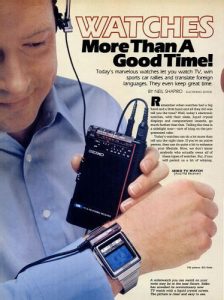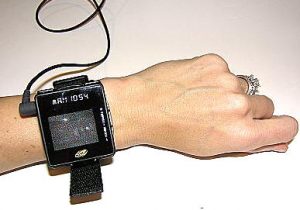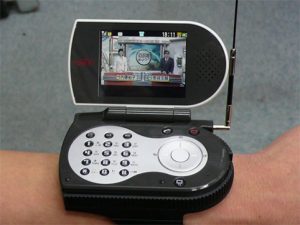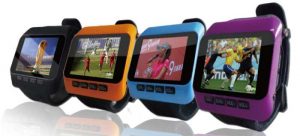Back in the early times of TV there were sci-Fi visions of miniaturized TVs in a wristwatch, probably first seen in early “Dick Tracy” comics. It was unavoidable that we’d get the TV wristwatch, the question was just “when?”.
In 1982 Seiko finally answered this question – with the first TV Wristwatch ever – the legendary “Seiko TV watch”. But let’s take a more detailed look at the history of TV Wristwatches…
1. Seiko TV Watch (1982)

It was introduced in summer 1982 in Japan – so that can be regarded as the birth of the TV Wristwatch. It was a bit cheating since you’d need to connect a walkman-sized receiver box that also contained the batteries as well as headphones in order to watch TV on a tiny greyscale display. In the end it would have been more practical to just bring the first Sony watchman which is pretty much the size of the receiver unit. The first (“Sports”) edition featured a black rim around the Watch face and came in a silver colored box. That is by far the rarest verson. The later “all silver” version was also released in the U.S. a year later.
2. NHJ Wearable TV VTV-101 (2004)

The NHJ VTV-101 was the first color TV watch and while it was still rather bulky for a wristwatch it contained the receiver in the watch eliminating the need to bring a box with you. What you’d definitely need to bring was the earphones – these also conatin the antenna, so even if you don’t need any sound you’ll not be able to watch TV without them. The watch itself is a bit bulky, but still kinda “wearable”. The TV module can be detached from the strap and be worn as a necklace. The box also contains a special docking station that you need to charge the batteries. So if the earphones or docking station get lost the unit will become pretty much unusable. The batteries last around 60 minutes, so usually a bit short for a soccer match or a movie. A bit later a PAL version called “VTV-201” was released. Unfortunately the PAL version lacked the watch display on top, so unless you turn it on it wouldn’t even show the time, thus defeating the purpose of a “watch” a bit.
3. “Super Dry” TV Watch (2006)

Probably the weirdest “watch” in this collection if you wanna call it “watch” at all is the “Super Dry TV Watch”. Actually it is rather a Japanese cell phone with a wrist strap. This is so bulky, i think you can only “wear” this as a cheap joke on a party or so. Well it does have a watch display on the outside, so when closed it would look like a ridiculous oversized digital watch. At least it contains a cell phone, speaker, antenna and everything so besides the bulky phone there’s nothing else you’d need to bring. Japanese “One-Seg” standard, so not really useful outside of Japan i guess. Interestingly this was never for sale – but you could win one of 5000 units in a sweepstakes from Asahi “Super Dry” beer. Thus probably the rarest TV watch ever, even in Japan this is difficult to get.
4. SUPRL SP-WTV01 (2012)

The last TV Wristwatch ever made and without doubt by far the best one. This is not just a color TV with retractable antenna, built-in speakers and FM radio – this one even supports virtually every TV standard ever – NTSC, PAL, SECAM and all kinds of different flavors of these standards. The watch is not so bulky and it can be charged by a standard micro-USB cable. You could also wear it like a pendant around your neck if you prefer that. If analog TV wouldn’t have been shut down already in most countries this would have been a “must have” – but unfortunately it came a bit late for most of us.
Unfortunately that’s it already. Hopefully we’ll one day get a (rather tiny) DVB-T2 wristwatch or so, but right now your collection is complete when you have these 4 models (And their variations if you’re extreme…).